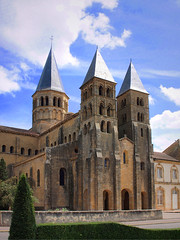
I went somewhere different for mass today - a church built about twenty-five years ago. The design was a break from tradition, with a short wide nave so that everyone was close to the sanctuary. The interior was exposed facing brick, the acoustic lively and the general ambience light and airy. The liturgy was spoken apart from the hymns. Thus it can be said to be an expression of the predominant theology of the post-Vatican II movement. Attendance at this, the main Sunday High Mass, was poor, with less than one-third of the places occupied - though it could be that many people were away on holiday.
It would be more difficult to construct such a building today, as there is a growing movement towards the use of the Extraordinary Form of the Mass, which in turn is having an influence on the way that the Ordinary Form of the Mass is celebrated. One thing that needs to be recognised is that whatever growth is taking place within the Catholic Church is focussed around the Extraordinary Form, which is in particular drawing young people of an intellectual bent.
That in turn raises the question of what forms of architecture would be suitable for a contemporary Catholic church? What is known as the Modern Movement - ie based on the principle that form should follow function - gives little direction. In a church, moreover, precisely the reverse tends to happen: function follows form. Obviously the building should provide a setting in which it is possible to carry out the liturgical actions, and the requirements of acoustics must be satisfied. After that, theological considerations come to the fore. What counts here is the symbolism, which quickly raises questions of architectural style. Reference to historic style then becomes inescapable.
Loaded
The difficulty, then, is that all historical styles are loaded with baggage - associations and connotation of one sort or another. Gothic is simply out of keeping with contemporary sentiment, whilst Classical and Baroque styles have overtones of triumphalism, having been favoured in the twentieth century by dictators such as Stalin and Mussolini. But the style usually referred to as Romanesque - a solid and stripped down classicism, seems to carry no such associations. Indeed, it is precisely the kind of church architecture that one might expect to be generated by applying the maxim "form follows function".
Kommentarer